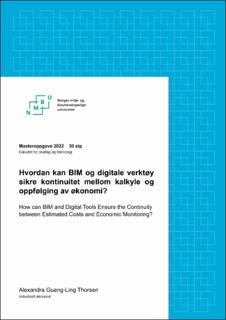| dc.contributor.advisor | Kjøllesdal, Øyvind | |
| dc.contributor.advisor | Bergh, Eva Gabrielle Héléne | |
| dc.contributor.author | Thorsen, Alexandra Guang-Ling | |
| dc.date.accessioned | 2022-11-21T14:10:28Z | |
| dc.date.available | 2022-11-21T14:10:28Z | |
| dc.date.issued | 2022 | |
| dc.identifier.uri | https://hdl.handle.net/11250/3033191 | |
| dc.description.abstract | Byggenæringen utgjør en stor del av Norges fastlandsøkonomi, og for å opprettholde verdiskapingen er næringen avhengig av digital transformasjon. Byggeprosjektenes økte kompleksitet fører til økt informasjonsmengde, og behov for flere ansatte ved planlegging og produksjon. Det stilles også større krav til rutiner og økonomisk oppfølging. BIM er en av de mest fremtredende prosessene innen digital utvikling i byggenæringen, og optimaliserings mulighetene det gir kan bidra til å håndtere prosjekters kompleksitet.
Etter hvert som byggeprosjekts kompleksitet øker, blir det mer krevende å følge opp økonomien. Et funn i denne studien viser at dagens digitale verktøy ikke egnes til oppfølging av økonomi knyttet til kalkylen i utførelsesfasen. Derav er det interessant å undersøke hvordan BIM og digitale verktøy kan bidra til å sikre bedre kontinuitet mellom entreprenørens kalkyle og økonomioppfølging i utførelsesfasen. Digitalisering, som er et verktøy for digital innovasjon, er derfor en verdifull bidragsyter for å håndtere prosessen knyttet til økonomioppfølging. En virksomhet som har fokus på digital innovasjon er AF gruppen, og i denne studien ble det derfor inngått et samarbeid med AF Gruppen.
Ved gjennomføring av denne studien ble kvalitativ forskningsmetode med semistrukturerte intervju benyttet, for å danne et helhetlig bilde av studiens tema fra entreprenørenes perspektiv. Studiens innsamlede data består av 13 individuelle intervjuer, hvorav informantene er aktører fra byggenæringens entreprenørside med kjennskap til BIM og digitale verktøy, samt kalkyle og økonomi i utførelsesfasen.
Studien avdekker at det finnes flere muligheter ved bruk av BIM og digitale verktøy for å sikre bedre kontinuitet mellom kalkyle og økonomioppfølging i utførelsesfasen. En av dem er at BIM-modellen kan benyttes til automatisert mengdeuttak, som bidrar til å effektivisere kalkulasjonsprosessen. Studien avdekker også utfordringer ved implementering av nye digitale verktøy i bransjen, der en av dem er å omstille de involverte. En mulig løsning studien kommer frem til er å utvikle brukervennlige systemer, og gjennomføre suksessfulle pilotprosjekter. Det konkluderes derfor med at bransjen må satse og investere i digitalisering, for å effektivisere byggeprosessen ved bruk av 4D og 5D BIM. På den måten kan kontinuiteten mellom kalkyle og økonomioppfølging sikres ved visualiserings- og simuleringsmuligheter, noe som også bidrar til bedre kostnadskontroll og vellykkede prosjekter. | en_US |
| dc.description.abstract | The construction industry accounts for a large part of the Norwegian mainland economy and to maintain the economic value creation in the industry, a transformation towards digitalization is decisive. The construction projects' increased complexity leads to increased information flow and the need for more labour in planning and production. The industry is also experiencing higher demands for routines and financial monitoring. The most evolving and widely used process in digital development in the building industry is BIM, and the opportunities for optimization BIM provides may contribute to managing the building projects' complexity.
In this study, future possibilities for BIM and digital tools are being examined to provide better continuity between the contractors' calculated costs and the financial monitoring in the construction phase. This is interesting to study because the building projects' financial monitoring will be more demanding as the buildings' complexity increases. Furthermore, today's digital tools are not suited for evaluating the building projects economic aspects. Digitalization, which is a tool in digital innovation, is, therefore, an important asset in monitoring the economic development of a project. AF Gruppen is a contracting and industrial group that values digital innovation, cooperation with AF Gruppen was for this reason developed in the making of this thesis.
The study utilized a qualitative research method and semi-structural interviews, to create a holistic picture of the studies' topics seen from the contractors' perspective The collected data consists of 13 individual interviews, in which the informants are actors from the entrepreneurial side, with BIM and digital tools knowledge, as well as the construction phase economy monitoring.
The study reveals opportunities for how BIM and digital tools can ensure continuity between economic costs and financial monitoring within the construction phase. Where an opportunity is BIM-based quantity take-off, which makes the calculation process more efficient. One main transformation challenge into a more digital building industry is to change the involved parties' attitudes. User-friendly systems and successful pilot projects might be a good contribution to solving the challenge. The building industry should invest in digitalization to increase the building process efficiency with 4D and 5D-BIM. By doing this the continuity between economic costs and financial monitoring is maintained by visualization and simulation possibilities, which in turn will contribute to better cost control. | en_US |
| dc.language.iso | nob | en_US |
| dc.publisher | Norwegian University of Life Sciences, Ås | en_US |
| dc.rights | Attribution-NonCommercial-NoDerivatives 4.0 Internasjonal | * |
| dc.rights.uri | http://creativecommons.org/licenses/by-nc-nd/4.0/deed.no | * |
| dc.title | Hvordan kan BIM og digitale verktøy sikre kontinuitet mellom kalkyle og oppfølging av økonomi? | en_US |
| dc.title.alternative | How can BIM and digital tools ensure the continuity between estimated costs and economic monitoring? | en_US |
| dc.type | Master thesis | en_US |
| dc.description.localcode | M-IØ | en_US |

